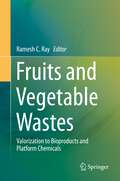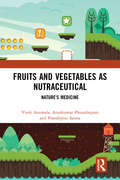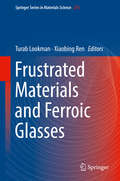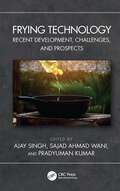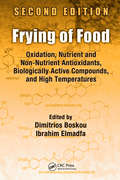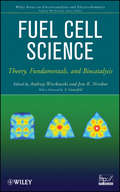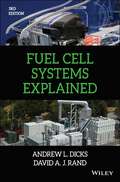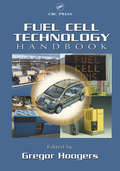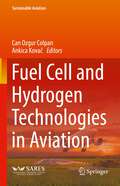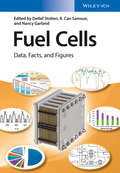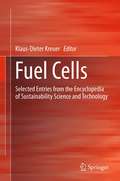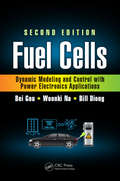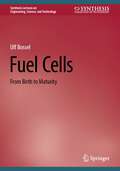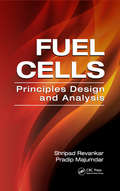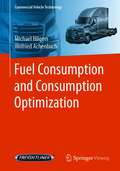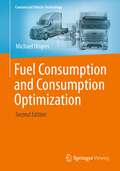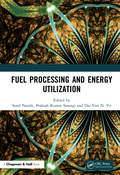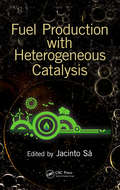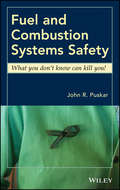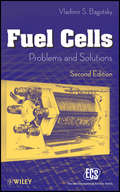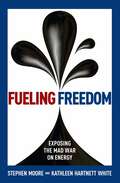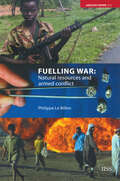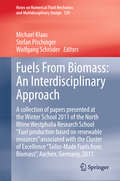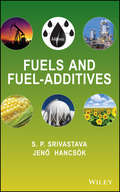- Table View
- List View
Fruits and Vegetable Wastes: Valorization to Bioproducts and Platform Chemicals
by Ramesh C. RayThis book puts together all aspects of valorization of vegetable and fruit wastes (VFWs) into different biocommodities and platform chemicals using fermentation and non-fermentation processes. VFWs are a special group of solid waste (biomass) that needs to be characterized to understand the nature of applications as raw materials and to propose an appropriate methodology for bioprocessing into value-added commodities. VFWs provide favorable conditions for the growth of microorganisms, and this opens up great opportunities for their use in fermentation processes. For example, VFWs can be used as a solid support, carbon, and nutrient source in fermentation for the production of a variety of value-added biocommodities such as enzymes, single-cell proteins, bioadsorbents, phenolic bioactive compounds, aroma and flavor compounds, and platform chemicals like lactic acid, bioethanol, and biobutanol. Researchers and academics in the area of environmental science and engineering, chemical engineering, biotechnology, life science, and food science and technology, undergraduate and graduate students, industry professionals, and policymakers will find this publication useful. Bioprocessing of agro-wastes is a recent technology for developing novel bioproducts. This book will also be of interest to the general public as a reference for all those interested in waste management.
Fruits and Vegetables as Nutraceutical: Nature's Medicine
by Vivek Anumala Arunkumar Phurailatpam Pranabjyoti SarmaCognizing the significance of fruits and vegetables in the human diet. This book is designed to provide an insight into the nutritional importance of fruits and vegetables in human health, disease prevention, managing stress and boosting immunity, especially in this COVID-19 pandemic. The book contains a very concise and precise information on nutraceuticals, their sources and benefits. It also contains the best possible information regarding common health issues faced by humans and their prevention with the help of bioactive compounds, maintaining a focus throughout on how nutraceuticals influence human health. The information provided in this book is truly based on scientific records of scientists working in the arena of bioactive compounds of fruits and vegetables and their role in disease prevention of humans as well as Food Safety and Standards Authority of India (FSSAI) acts and regulations.Note: Taylor & Francis does not sell or distribute the hardback in India, Pakistan, Nepal, Bhutan, Bangladesh and Sri Lanka.
Fruits of the Brazilian Cerrado: Composition and Functional Benefits
by Fernando Freitas de Lima Caroline Honaiser Lescano Ivan Pires de OliveiraFruits of the Brazilian Cerrado: Composition and Functional Benefits describes the nutritional, chemical and physical characteristics of the fruits of the Cerrado, as well as their pharmacological effects and use in phytotherapics. Chapters are dedicated to the morphological characteristics, macronutrients, micronutrients and active compounds of various fruits, with separate sections covering their peels, leaves, nuts, pulps, and other components.The text also includes detailed studies on the treatment of diseases with these natural products, as well as their applications in popular use by local communities. Authors explain the importance of bioactive compounds found in the fruits and their possible mechanisms of action in the organism. This text thus provides a valuable reference to researchers studying a range of topics, including functional foods, phytotherapy, and plant science.
Frustrated Materials and Ferroic Glasses (Springer Series in Materials Science #275)
by Turab Lookman Xiaobing RenThis book provides a comprehensive introduction to ferroics and frustrated materials. Ferroics comprise a range of materials classes with functionalities such as magnetism, polarization, and orbital degrees of freedom and strain. Frustration, due to geometrical constraints, and disorder, due to chemical and/or structural inhomogeneities, can lead to glassy behavior, which has either been directly observed or inferred in a range of materials classes from model systems such as artificial spin ice, shape memory alloys, and ferroelectrics to electronically functional materials such as manganites. Interesting and unusual properties are found to be associated with these glasses and have potential for novel applications. Just as in prototypical spin glass and structural glasses, the elements of frustration and disorder lead to non-ergodocity, history dependence, frequency dependent relaxation behavior, and the presence of inhomogeneous nano clusters or domains. In addition, there are new states of matter, such as spin ice; however, it is still an open question as to whether these systems belong to the same family or universality class.The purpose of this work is to collect in a single volume the range of materials systems with differing functionalities that show many of the common characteristics of geometrical frustration, where interacting degrees of freedom do not fit in a lattice or medium, and glassy behavior is accompanied by additional presence of disorder. The chapters are written by experts in their fields and span experiment and theory, as well as simulations. Frustrated Materials and Ferroic Glasses will be of interest to a wide range of readers in condensed matter physics and materials science.
Frying Technology: Recent Development, Challenges, and Prospects
by Ajay Singh Sajad Ahmad Wani Pradyuman KumarCovering all the recently adapted developments, challenges, and other healthy approaches in the process of frying, this book provides the details of various frying technologies and discusses its operations and machinery in depth. Emphasis is placed on healthy prospects, nutritional values, and the emerging threats (e.g., acrylamide, acrolein, oxidation, rancidity and other hydroperoxides) of the frying process and effective ways to minimize them. Key Features Provides a complete guide to production and consumption of fried foods along with discussions on packaging and labeling with global perspectives Discusses textural, sensory and nutritional profiles of fried, baked, and puffed foods Explains the impact of frying on macromolecular constituents, fats/oils, starches, and proteins A cohesive exploration of food-frying technology, this book appeals to students, academicians, researchers and professionals in the fields of nutrition and food sciences.
Frying of Food: Oxidation, Nutrient and Non-Nutrient Antioxidants, Biologically Active Compounds and High Temperatures, Second Edition
by Dimitrios Boskou Ibrahim ElmadfaFrying of Food is the first reference to examine frying of food from the point of view of changes occurring to biologically-active constituents and the effects of such changes on the stability, performance and nutritive value of frying oil. It focuses on the nature of the frying media and discusses changes to non-glyceride components, especially nu
Fuel Cell Science
by Jens Norskov Andrzej Wieckowski S. GottesfeldA comprehensive survey of theoretical andexperimental concepts in fuel cell chemistryFuel cell science is undergoing significant development, thanks, in part, to a spectacular evolution of the electrocatalysis concepts, and both new theoretical and experimental methods. Responding to the need for a definitive guide to the field, Fuel Cell Science provides an up-to-date, comprehensive compendium of both theoretical and experimental aspects of the field.Designed to inspire scientists to think about the future of fuel cell technology, Fuel Cell Science addresses the emerging field of bio-electrocatalysis and the theory of heterogeneous reactions in fuel cell science and proposes potential applications for electrochemical energy production. The book is thorough in its coverage of the electron transfer process and structure of the electric double layer, as well as the development of operando measurements. Among other subjects, chapters describe: Recently developed strategies for the design, preparation, and characterization of catalytic materials for fuel cell electrodes, especially for new fuel cell cathodes A wide spectrum of theoretical and computational methods, with?the aim of?developing?new fuel cell catalysis concepts and improving existing designs to increase their performance.?Edited by two leading faculty, the book: Addresses the emerging fields of bio-electrocatalysis for fuel cells and theory of heterogeneous reactions for use in fuel cell catalysis Provides a survey of experimental and theoretical concepts in these new fields Shows the evolution of electrocatalysis concepts Describes the chemical physics of fuel cell reactions Forecasts future developments in electrochemical energy production and conversion Written for electrochemists and electrochemistry graduate students, electrocatalysis researchers, surface and physical chemists, chemical engineers, automotive engineers, and fuel cell and energy-related researchers, this modern compendium can help today's best minds meet the challenges in fuel science technology.
Fuel Cell Systems Explained
by Andrew L. Dicks David A. RandSince publication of the first edition of Fuel Cell Systems Explained, three compelling drivers have supported the continuing development of fuel cell technology. These are: the need to maintain energy security in an energy-hungry world, the desire to move towards zero-emission vehicles and power plants, and the mitigation of climate change by lowering of CO2 emissions. New fuel cell materials, enhanced stack performance and increased lifetimes are leading to the emergence of the first truly commercial systems in applications that range from fork-lift trucks to power sources for mobile phone towers. Leading vehicle manufacturers have embraced the use of electric drive-trains and now see hydrogen fuel cells complementing advanced battery technology in zero-emission vehicles. After many decades of laboratory development, a global but fragile fuel cell industry is bringing the first commercial products to market. This thoroughly revised edition includes several new sections devoted to, for example, fuel cell characterisation, improved materials for low-temperature hydrogen and liquid-fuelled systems, and real-world technology implementation. Assuming no prior knowledge of fuel cell technology, the third edition comprehensively brings together all of the key topics encompassed in this diverse field. Practitioners, researchers and students in electrical, power, chemical and automotive engineering will continue to benefit from this essential guide to the principles, design and implementation of fuel cell systems.
Fuel Cell Technology Handbook
by Gregor HoogersFuel cell systems have now reached a degree of technological maturity and appear destined to form the cornerstone of future energy technologies. But the rapid advances in fuel cell system development have left current information available only in scattered journals and Internet sites. The even faster race toward fuel cell commercialization further
Fuel Cell and Hydrogen Technologies in Aviation (Sustainable Aviation)
by Can Ozgur Colpan Ankica KovačThis book explores cutting-edge topics on hydrogen and fuel cell technologies in aviation. Coverage includes comparisons with conventional technologies, hydrogen storage options, energy management strategies, life cycle assessment, and application of fuel cells in different aerial vehicle classes. It also offers insights into recent progress and new technological developments in the field, along with case studies and practical applications. Fuel Cell and Hydrogen Technologies in Aviation is an invaluable guide for students, researchers, and engineers working on sustainable air transportation and the performance and environmental analysis of fuel cell-powered aerial vehicles.
Fuel Cells
by Detlef Stolten Remzi C. Samsun Nancy GarlandThis ready reference is unique in collating in one scientifically precise and comprehensive handbook the widespread data on what is feasible and realistic in modern fuel cell technology.Edited by one of the leading scientists in this exciting area, the short, uniformly written chapters by around 50 authors (many of them at the International Energy Agency) provide economic data for cost considerations and a full overview of demonstration data, covering such topics as fuel cells for transportation, fuel provision, codes and standards. The result is highly reliable facts and figures for engineers, researchers and decision makers working in the field of fuel cells.
Fuel Cells
by Klaus-Dieter KreuerThe expected end of the "oil age" will lead to increasing focus and reliance on alternative energy conversion devices, among which fuel cells have the potential to play an important role. Not only can phosphoric acid and solid oxide fuel cells already efficiently convert today's fossil fuels, including methane, into electricity, but other types of fuel cells, such as polymer electrolyte membrane fuel cells, have the potential to become the cornerstones of a possible future hydrogen economy. Featuring 21 peer-reviewed entries from the Encyclopedia of Sustainability Science and Technology, Fuel Cells offers concise yet comprehensive coverage of the current state of research and identifies key areas for future investigation. Internationally renowned specialists provide authoritative introductions to a wide variety of fuel cell types, and discuss materials, components, and systems for these technologies. The entries also cover sustainability and marketing considerations, including comparisons of fuel cells with alternative technologies.
Fuel Cells: Dynamic Modeling and Control with Power Electronics Applications, Second Edition (Power Electronics and Applications Series)
by Bei Gou Woonki Na Bill DiongThis book describes advanced research results on Modeling and Control designs for Fuel Cells and their hybrid energy systems. Filled with simulation examples and test results, it provides detailed discussions on Fuel Cell Modeling, Analysis, and Nonlinear control. Beginning with an introduction to Fuel Cells and Fuel Cell Power Systems, as well as the fundamentals of Fuel Cell Systems and their components, it then presents the Linear and Nonlinear modeling of Fuel Cell Dynamics. Typical approaches of Linear and Nonlinear Modeling and Control Design methods for Fuel Cells are also discussed. The authors explore the Simulink implementation of Fuel Cells, including the modeling of PEM Fuel Cells and Control Designs. They cover the applications of Fuel cells in vehicles, utility power systems, and stand-alone systems, which integrate Fuel Cells, Wind Power, and Solar Power. Mathematical preliminaries on Linear and Nonlinear Control are provided in an appendix.
Fuel Cells: From Birth to Maturity (Synthesis Lectures on Engineering, Science, and Technology)
by Ulf BosselThe book presents the scientific history of the early days of fuel cells (1838 to 1845). The fuel cell effect was discovered by the Swiss scientist Christian Friedrich Schoenbein. while the English lawyer and scientist William Robert Grove perfected the idea into a working power source. But around 1870 Siemens invented the power generator and electricity was produced by rotating shafts of water wheels, engines and turbines. The book presents for the first time the complete communication between C. F. Schoenbein and R. W. Grove (1838 to 1868). Also, the original analysis based on the physical understanding of 1850 has also been revised and corrected. The updated fuel cell analysis leads to full agreement between theory and experiment.Updated and corrected fuel cell theoryHistoric review of discovery of fuel cell effect and early development of fuel cell generatorsComplete correspondence between Schoenbein and Grove from 1838 to 1868 (first publication)
Fuel Cells: Principles, Design, and Analysis (Mechanical and Aerospace Engineering Series)
by Shripad T. Revankar Pradip MajumdarFuel Cells: Principles, Design, and Analysis considers the latest advances in fuel cell system development and deployment, and was written with engineering and science students in mind. This book provides readers with the fundamentals of fuel cell operation and design, and incorporates techniques and methods designed to analyze different fuel cell
Fuel Consumption and Consumption Optimization (Commercial Vehicle Technology)
by Michael Hilgers Wilfried AchenbachThe aim of this work, consisting of 9 individual, self-contained booklets, is to describe commercial vehicle technology in a way that is clear, concise and illustrative. Compact and easy to understand, it provides an overview of the technology that goes into modern commercial vehicles.Starting from the customer's fundamental requirements, the characteristics and systems that define the design of the vehicles are presented knowledgeably in a series of articles, each of which can be read and studied on their own. In this volume, Fuel Consumption and Consumption Optimization, the main focus is placed on the factors for optimizing consumption in the conventional vehicle. Fuel consumption can be optimized by four different factors: the technology of the vehicle, the conditions of its operation, the behavior of the driver and the maintenance and upkeep of the vehicle. These aspects are described in a way that is easily understood for training and practical application.
Fuel Consumption and Consumption Optimization (Commercial Vehicle Technology)
by Michael HilgersThe aim of this work, consisting of 9 individual, self-contained booklets, is to describe commercial vehicle technology in a way that is clear, concise and illustrative. Compact and easy to understand, it provides an overview of the technology that goes into modern commercial vehicles.Starting from the customer's fundamental requirements, the characteristics and systems that define the design of the vehicles are presented knowledgeably in a series of articles, each of which can be read and studied on their own. In this volume, Fuel Consumption and Consumption Optimization, the main focus is placed on the factors for optimizing consumption in the conventional vehicle. Fuel consumption can be optimized by four different factors: the technology of the vehicle, the conditions of its operation, the behavior of the driver and the maintenance and upkeep of the vehicle. These aspects are described in a way that is easily understood for training and practical application.
Fuel Processing and Energy Utilization
by Prakash Kumar Sarangi Sonil Nanda Dai-Viet N. VoThis book provides different aspects on fuel processing and refinery for energy generation. Most updated research findings along with case studies, real scenario examples, and extensive analyses of original research work and literature reviews is included in this book.
Fuel Production with Heterogeneous Catalysis
by Jacinto SáThis book presents the current state of the art and future perspectives of the heterogeneous catalytic production of fuels, complete with reaction mechanism schemes, engineering solutions, and valuable industry insights. It describes production of fuels from renewable sources using environmentally friendly technologies, exposing the advantages and disadvantages of each production process and suggesting solutions to minimize the impact of fuel transportation. Comprised of chapters authored by leading experts in the field, this authoritative text conveys the importance of catalysis for the sustainable production of fuels.
Fuel and Combustion Systems Safety
by John R. PuskarPractical, easy-to-follow advice that saves livesBased on the author's thirty years of hands-on experience working in the field of industrial fuel systems and combustion equipment safety, this book integrates safety codes with practical, tested, and proven guidance that makes it viable to specify, operate, and maintain industrial fuel and combustion systems as safely as possible. Readers will learn about fuels, piping, combustion, controls, and risks from more than fifty "real-life stories" the author has integrated into each chapter so one can immediately see and understand the concepts presented.The incidents depicted resulted in forty-six deaths, hundreds of serious injuries, and billions of dollars in losses. Each example is followed by lessons learned, helping readers understand what could have been done to avoid the disaster or minimize the resulting destruction of life and property.The book begins with an introductory chapter that presents key concepts in industrial fuel and combustion systems safety. Next, chapters cover such topics as:Combustion and natural gas piping basicsGas supply system issuesGas piping repairs and cleaningFuel trains and combustion equipmentBoilers and their unique risksControlling combustion risks: people, policy, equipmentThe final two chapters address risks related to facilities outside of the United States, as well as business contingency planning related to fuels and combustion equipment. The last chapter explains how to plan for and then respond quickly and effectively to fuel or combustion system incidents.Filled with practical, easy-to-follow advice that saves lives, Fuel and Combustion Systems Safety is an essential reference for everyone from equipment operators and maintenance personnel to corporate risk managers and global safety directors.
Fuel cells
by Vladimir S. BagotskyThe comprehensive, accessible introduction to fuel cells, their applications, and the challenges they pose Fuel cells-electrochemical energy devices that produce electricity and heat-present a significant opportunity for cleaner, easier, and more practical energy. However, the excitement over fuel cells within the research community has led to such rapid innovation and development that it can be difficult for those not intimately familiar with the science involved to figure out exactly how this new technology can be used. Fuel Cells: Problems and Solutions, Second Edition addresses this issue head on, presenting the most important information about these remarkable power sources in an easy-to-understand way. Comprising four important sections, the book explores: The fundamentals of fuel cells, how they work, their history, and much more The major types of fuel cells, including proton exchange membrane fuel cells (PEMFC), direct liquid fuel cells (DLFC), and many others The scientific and engineering problems related to fuel cell technology The commercialization of fuel cells, including a look at their uses around the world Now in its second edition, this book features fully revised coverage of the modeling of fuel cells and small fuel cells for portable devices, and all-new chapters on the structural and wetting properties of fuel cell components, experimental methods for fuel cell stacks, and nonconventional design principles for fuel cells, bringing the content fully up to date. Designed for advanced undergraduate and graduate students in engineering and chemistry programs, as well as professionals working in related fields, Fuel Cells is a compact and accessible introduction to the exciting world of fuel cells and why they matter.
Fueling Freedom: Exposing the Mad War on Energy
by Stephen Moore Kathleen Hartnett WhiteFossil fuel energy is the lifeblood of the modern world. Before the Industrial Revolution, humanity depended on solar energy captured in living plants. But with the ability to harness the energy in coal and other fossil fuels, human quality of life and capacity for progress increased exponentially. With the recent advent of safe fracking techniques and incredible innovations in the energy industry, fossil fuels are as promising an energy resource as ever. Yet, highly politicized climate policies are pushing a grand-scale shift to new and less efficient energy sources. Is such a shift really necessary? If fossil fuel energy is supplanted by less efficient and less affordable alternatives for political reasons, will the modern world suffer?
Fuelling War: Natural Resources and Armed Conflicts (Adelphi series #373)
by Philippe Le BillonA generous endowment of natural resources should favour rapid economic and social development. The experience of countries like Angola and Iraq, however, suggests that resource wealth often proves a curse rather than a blessing. Billions of dollars from resource exploitation benefit repressive regimes and rebel groups, at a massive cost for local populations. This Adelphi Paper analyses the economic and political vulnerability of resource-dependent countries; assesses how resources influence the likelihood and course of conflicts; and discusses current initiatives to improve resource governance in the interest of peace. It concludes that long-term stability in resource-exporting regions will depend on their developmental outcomes, and calls for a broad reform agenda prioritising the basic needs and security of local populations.
Fuels From Biomass: An Interdisciplinary Approach
by Michael Klaas Stefan Pischinger Wolfgang SchröderThe book reports on the results of the BrenaRo Winterschool 2011, held on November 21-22 in Aachen, Germany. The different chapters cover a number of aspects of the topic of energy generation, with a particular focus on energy generation from biomass. They presents new findings concerning engine development, process engineering, and biological and chemical conversion of biomass to fuels, and highlight the importance of an interdisciplinary approach, combining chemistry, biology and engineering research, to the use of renewable energy sources. All in all, this book provides readers with a snapshot of the state-of-the-art in renewable energy conversion, and gives an overview of the ongoing work in this field in Germany.
Fuels and Fuel-Additives
by S. P. Srivastava Jenõ HancsókExamines all stages of fuel production, from feedstocks to finished productsExploring chemical structures and properties, this book sheds new light on the current science and technology of producing energy efficient and environmentally friendly fuels. Moreover, it explains the role of fuel-additives in the production cycle. This expertly written and organized guide to fuels and fuel-additives also presents requirements, rules and regulations, including US and EU standards governing automotive emissions, fuel quality and specifications, alternate fuels, biofuels, antioxidants, deposit control detergents/dispersants, stabilizers, corrosion inhibitors, and polymeric fuel-additives.Fuels and Fuel-Additives covers all stages and facets of the production of engine fuels as well as heating and fuel oils. The book begins with a quick portrait of the future of fuels and fuel production. Then, it sets forth the regulations controlling exhaust gas emissions and fuel quality from around the world. Next, the book covers:Processing of engine fuels derived from crude oil, including the production of blending componentsProduction of alternative fuelsFuel-additives for automotive enginesBlending of fuelsKey properties of motor fuels and their effects on engines and the environmentAviation fuelsThe final chapter of the book deals with fuel oils and marine fuels. Each chapter is extensively referenced, providing a gateway to the primary and secondary literature in the field. At the end of the book, a convenient glossary defines all the key terms used in the book.Examining the full production cycle from feedstocks to final products, Fuels and Fuel-Additives is recommended for students, engineers, and scientists working in fuels and energy production.
